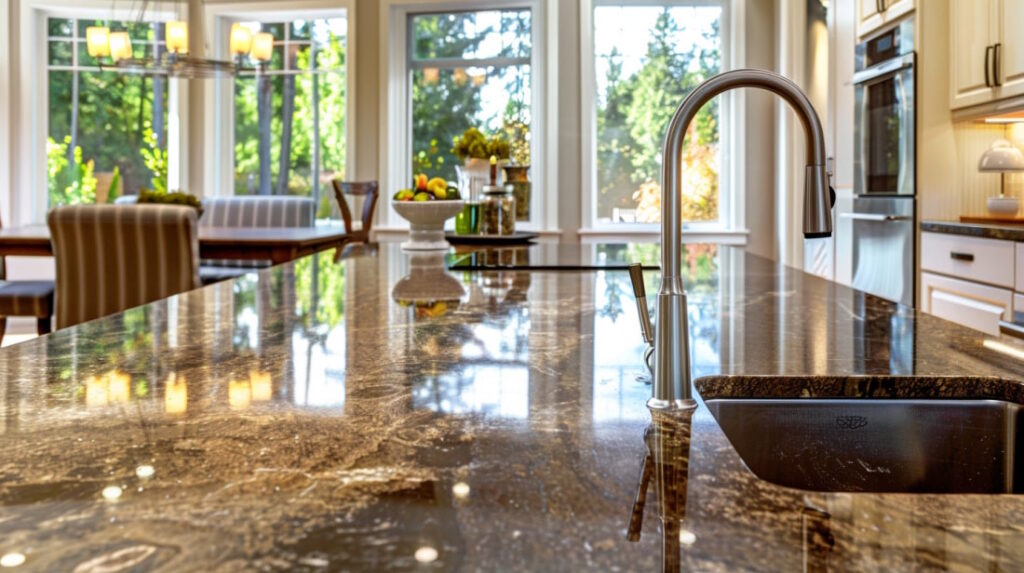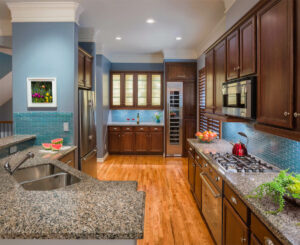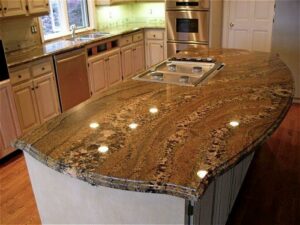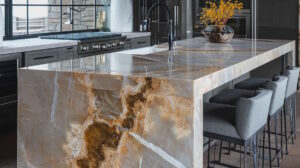Essential Supplies:
- Dish soap
- Water
- Sponge
- Isopropyl alcohol
- Spray bottle
- Clean cloth or towel
- Baking soda and plastic wrap (optional)
- Razor blade and gloves (optional)
If you’re passionate about cooking, granite countertops can be a fantastic addition to your kitchen. Known as one of the most durable countertop materials available, granite is resistant to scratches and can handle daily wear and tear exceptionally well. Its impressive heat resistance is another bonus. Although granite is porous and absorbs liquids, applying a sealant annually ensures its long-term durability. Simply follow the instructions on the sealant package for easy application.
Maintaining cleanliness is equally crucial as sealing your granite countertops. Below, you’ll find step-by-step instructions for creating a DIY granite cleaner to keep your counters sparkling.
Clear the Counters
Start by removing everything from your countertops, including appliances, crockery, and decorative items. Relocate them to another surface, such as the kitchen table or stovetop. Once the counters are cleared of large items, sweep away any debris with a dry sponge.
Scrub the Surface
Granite countertops have a sealant that keeps them shiny and resistant to stains, so it’s best to avoid highly acidic or basic cleaners. Regular use of vinegar, Windex, or bleach can make granite lose its luster and compromise the sealant. Instead, use mild soap and water. Apply warm water and dish soap to a sponge, work up a lather, and start cleaning. Stay away from abrasive pads to prevent scratching the granite. Clean the surface in an “S” pattern, moving from back to front. For tough or sticky spills, you may need to scrub a little more.
Remove Stubborn Stains
For particularly stubborn stains, a razor blade may be necessary. Carefully scrape away any residue or buildup using the blade, ensuring the entire edge rests flat against the countertop to prevent scratching. After removing the gunk, rinse and wring out your sponge, then wipe away the suds. You may need to repeat this process a few times to ensure the countertops are free of suds or puddles. Remember to wear gloves when handling sharp tools.
If a razor blade isn’t available, another way to tackle stubborn granite stains is by creating a paste of baking soda and water. Gently scrub the stain with this paste using a soft cloth, then rinse thoroughly. It may require multiple attempts to remove particularly stubborn spots. For exceptionally tough stains, apply the paste to the affected area, cover it with plastic wrap, and secure the edges with tape. Allow it to sit until the paste dries completely, which could take a few days. Once dried, wipe off the paste with a soft cloth and rinse with warm water.
Disinfect the Surface
Prepare a disinfecting solution by mixing equal parts of isopropyl alcohol and water in a spray bottle—use one cup of each. Spray the mixture evenly across the countertop and let it sit for five minutes. After the time has elapsed, use a clean dish towel to wipe down the counters, moving from back to front in a sweeping “S” motion. Following these steps will ensure your countertops are both clean and disinfected.
Add Shine
For a glossy finish, apply a small amount of cooking oil to a soft cloth and gently rub it over the granite surface. Buff it gently to add a subtle sheen and increase the countertop’s stain resistance.
Despite following proper cleaning techniques, your granite countertop will eventually need to be resealed due to regular wear and tear, which gradually wears away the sealant. This can leave the surface dull and prone to stains. By maintaining the right cleaning habits, you’ll help the sealant last longer, keeping your granite countertop looking beautiful for years.
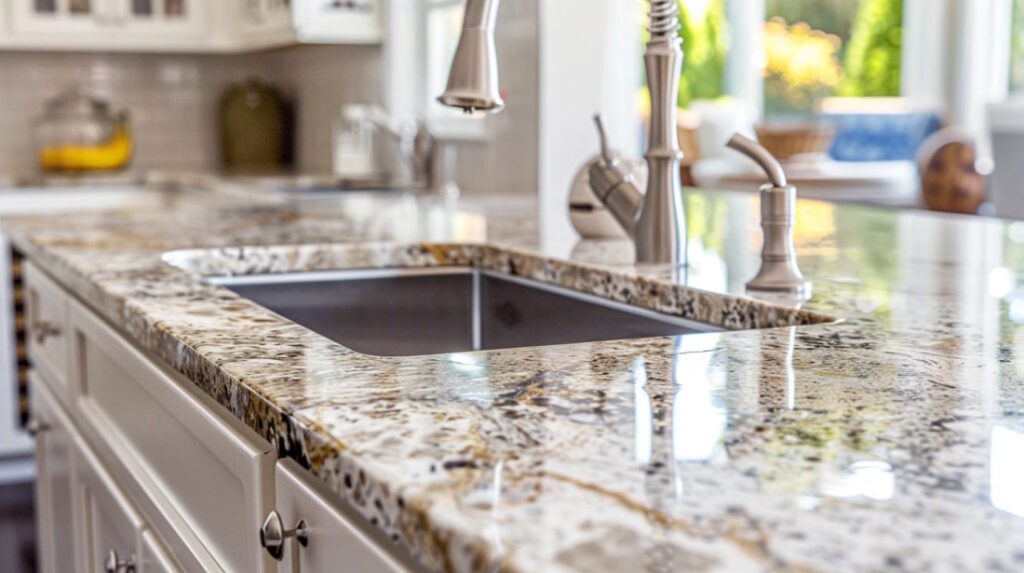
Long-term Maintenance Tips
To maintain the beauty and durability of your granite countertops over the years, follow these essential long-term care tips:
Use Cutting Boards:
- Purpose: Cutting directly on granite might not visibly damage it immediately, but over time, it can lead to scratches and dulling.
- Practice: Always use cutting boards for chopping, slicing, or dicing.
Avoid Excessive Weight:
- Purpose: Granite is strong but not indestructible. Excessive weight can cause cracks or structural damage.
- Practice: Never sit, stand, or place extremely heavy items on the countertop surface.
Hot Pads and Trivets:
- Purpose: Thermal shock can occur when a hot pan is placed directly on a cold countertop, leading to cracks.
- Practice: Always use hot pads or trivets when placing hot pots, pans, or appliances on granite.
Clean Spills Promptly:
- Purpose: Granite is porous, so leaving spills unattended can result in stains.
- Practice: Immediately clean spills, especially acidic substances like wine, coffee, or citrus juice, to prevent etching and discoloration.
Regular Sealing:
- Purpose: Sealing ensures the granite remains non-porous and stain-resistant.
- Practice: Perform a water test every 6-12 months to determine if resealing is required. If water absorbs into the granite within 5 minutes, reseal the surface.
Polishing:
- Purpose: Polishing granite helps to maintain its natural shine and protective coating.
- Practice: Use a granite polish every 1-2 months or as needed.
Avoid Abrasive Cleaners:
- Purpose: Harsh chemicals can etch or dull the granite surface.
- Practice: Stick to mild, pH-neutral cleaners or those specifically formulated for granite.
Inspect for Damage:
- Purpose: Catching cracks, chips, or dull spots early allows for timely repair, preventing further deterioration.
- Practice: Regularly inspect the surface and edges for any signs of damage.
Address Stains Immediately:
- Purpose: Old stains are much harder to remove than fresh ones.
- Practice: Use appropriate stain removal techniques as soon as a stain appears.
Educate Household Members:
- Purpose: Ensuring everyone understands proper granite care minimizes accidental damage.
- Practice: Share these tips with family or roommates to reinforce good habits.
By adhering to these long-term maintenance practices, you’ll be able to enjoy the natural beauty and resilience of your granite countertops for many years to come.
Frequently Asked Questions
Q: How often should I clean my granite countertops?
A: Daily cleaning with a microfiber cloth and a mild cleaner is recommended. For more thorough cleaning, deep clean once a week with a pH-balanced granite cleaner or a mixture of isopropyl alcohol and water.
Q: How often should I reseal my granite countertops?
A: The sealing frequency depends on the type of granite and usage level. A good rule of thumb is every 6 to 12 months. Perform a water test to see if resealing is required: pour a small amount of water on the countertop, and if it absorbs within 5 minutes, it’s time to reseal.
Q: What should I avoid when cleaning granite countertops?
A: Avoid acidic cleaners like vinegar or lemon juice, abrasive scrubbers, and harsh chemicals like bleach or ammonia. These can etch or dull the surface.
Q: Can I cut directly on granite countertops?
A: Although granite is scratch-resistant, cutting directly on the surface can cause scratches over time and dull your knives. It’s best to use a cutting board.
Q: Why does my granite countertop look cloudy after cleaning?
A: Cloudiness can occur due to residue buildup from soaps, improper cleaners, or hard water. Use a granite cleaner or a mixture of isopropyl alcohol and water to remove the residue and restore the shine.
Q: What should I do if my granite countertop is stained?
A: The appropriate stain removal method depends on the type of stain. Create a paste using baking soda and water or hydrogen peroxide, apply it to the stain, cover with plastic wrap, and let it sit for 24 hours before rinsing off.
Q: Is it necessary to polish granite countertops?
A: Polishing helps maintain the natural shine and gives the countertop a protective layer. It’s not mandatory, but polishing every 1-2 months can improve the overall appearance.
Q: Can I use commercial disinfectant wipes on granite?
A: Most commercial disinfectant wipes contain chemicals that can damage the sealant on granite. Instead, use a solution of isopropyl alcohol and water or a granite-specific disinfectant.
Q: How do I repair small chips or cracks in my granite countertop?
A: Minor chips can often be filled with clear epoxy or a stone repair kit available at hardware stores. For larger cracks or severe damage, consider professional repair to ensure a seamless fix.
Q: How do I know if my granite is properly sealed?
A: Perform the water test by pouring a few drops of water on the surface. If the water beads up, the sealer is intact. If it absorbs into the granite, it’s time to reseal.

